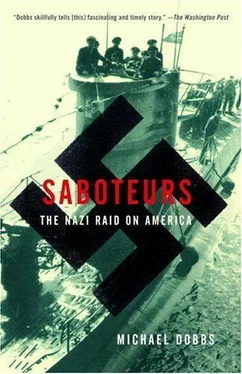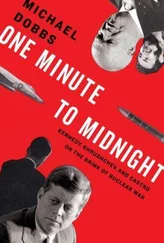FOR THE V-men on board U-202, this was easily the most uncomfortable of several trips across the Atlantic. All four had arrived in America for the first time in the twenties as refugees from the street violence, mass unemployment, and hyperinflation afflicting the Weimar Republic. For these new arrivals, America represented a beacon of peace and prosperity, a chance to make a new life far away from European conflicts.
Dasch’s story was typical. After dropping out of the Catholic convent of the Sacred Heart in Düsseldorf in 1920 at the age of seventeen, he was desperate to find a means to support himself. He earned some money as a housepainter and working in the mines, but was unable to get a regular job and was constantly broke. In 1922, he went to the north German port of Hamburg hoping to stow himself away on a ship bound for America. The harbor was guarded, but he got into the docks by mingling with a large group of workers.
He looked for a ship with an American flag and attracted the attention of a cook, who was throwing scraps overboard. “I’m hungry and need work,” Dasch shouted, gesturing to his stomach and hands. 24The cook took pity on him and helped him board the ship by acting drunk. Once on board, he washed dishes for the cook in return for his first American-style meal of corned beef and cabbage.
One of the crew members on the Kerr Line’s SS Schohary was a German-American from Philadelphia who entertained Dasch with tales of life in America, strengthening his determination to get there. During his free time, he looked for a place to hide when the boat sailed. He settled on a storeroom on the second deck, amidships, where he could come and go as he pleased. Just before the ship sailed, he bid farewell to his new friends but, instead of going ashore, went to his hiding place. The only document in his possession was his birth certificate.
He slept during the day and came out of his hiding place at night to scrounge for leftover food from the mess hall. The Atlantic crossing took seventeen days, and the ship reached Philadelphia on Columbus Day, 1922. At Government Pier, he walked down the gangplank with a group of workers and sailors, evading immigration officials, and went into the city looking for work. A German baker offered him a job as a dishwasher, paying him five dollars for a week’s work and allowing him to sleep in his cellar. That was enough to bum his way to New York.
A succession of restaurant jobs followed, such as caterer’s assistant, fry cook, and soda fountain clerk. By the end of his first year in America, Dasch had saved eight hundred dollars and was anxious to rectify his status as an illegal immigrant. At that time, immigration authorities took a relatively benign view of hungry European seamen jumping ship in American ports. After determining that he had saved up some money and had “the makings of a good American citizen,” they instructed him to pay $8.16 in head tax and issued him an alien seaman identification card bearing the stamp “Legally admitted to the United States.” 25
Heinrich Heinck and Richard Quirin left Germany for similar reasons, because they were penniless and needed work. Heinck got a job as a seaman on the Hamburg-American Line and jumped ship on his third trip to New York. Quirin received a quota immigrant visa in Germany with the help of an affidavit from an uncle living in Schenectady, New York, who promised to support him once he got to America.
Peter Burger’s motives for fleeing Germany for America were slightly different. As an early supporter of Hitler, he felt threatened by the political backlash that followed the failure of the Munich beer hall putsch in 1923. There seemed “very little future for remaining in Germany,” and he was constantly in “fear of terrorist acts” by Communists and other left-wingers hunting down the remnants of the Nazi Party. 26An aunt living in Milwaukee sent him an affidavit for a quota immigrant visa, and Burger sailed to New York aboard a German steamer in February 1927. At the time he left Germany, the prospect of Hitler coming to power appeared remote.
Of the second group of saboteurs, on U-584, only Kerling was an early Nazi Party member. Like Burger, he was discouraged by the political setbacks experienced by the Nazis in the twenties, and immigrated legally to the United States as a quota immigrant in March 1929. His first job was smoking hams in Brooklyn. Both Werner Thiel and Hermann Neubauer left Germany for economic reasons, Thiel arriving in America in 1927 as a quota immigrant and Neubauer jumping ship in 1931 after working his way across the Atlantic as a cook. Herbie Haupt arrived in the United States at the age of five in 1925 with his mother, following in the footsteps of his father, an unemployed World War I veteran.
By the late thirties, the political and economic dynamic that had caused this wave of German immigration to the United States was at least partially reversed. The effects of the Depression were still lingering and it was difficult for new immigrants to find good jobs. America had lost some of its allure: all of a sudden, it was Hitler’s Germany that seemed to represent the wave of the future. The tired and huddled masses yearned for a sense of direction, and the Fatherland beckoned them home.
LINDER PLOTTED the course of U-202 every day on charts attached to the table in the control room, marking out the distance traveled the previous day. He followed the route established by the German government as a safe zone for neutral shipping, from Lorient southwest to a point just north of the Azores, and then a sharp turn to the northeast toward Labrador. 27Here, in the warm waters of the Gulf Stream, they enjoyed a few days of the “most marvelous weather.” 28Linder took advantage of the calm weather to send the crew out on deck to grease the ship’s 88 mm and 20 mm guns and practice inflating the rubber dinghy to be used for landing the saboteurs on Long Island. The weather turned much colder when they reached the vicinity of Newfoundland.
Even though their primary mission was to transport the V-men across the Atlantic, the crew of U-202 were hunters by profession. They greeted each other in the morning with talk like “I hope we are going to shoot something today” and boasted about becoming the first to spot a steamer when they went on watch duty. 29Near the Azores, they spotted a steamship and a three-masted Portuguese schooner sailing close to the wind. Linder let the schooner pass as a neutral, and decided he did not have enough time to chase the steamer, which was headed in the wrong direction. “I have no time for a long hunt, as I have only ten more days to take care of my special assignment,” he noted in his log for June 2. 30
A few days later, as U-202 traveled down the Newfoundland coast, it received a radio message from another U-boat, alerting them to a 20,000-ton Allied steamer traveling from Halifax to Boston. His hunting instincts aroused, Linder at once ordered an increase in speed to twelve knots, but confided to Dasch that there was only “one chance in a hundred” of sinking it. 31Catching up with the steamer was impossible: it could make twenty knots, four knots more than the U-boat. The only hope of intercepting it was by chance. After a day or so, Linder abandoned the chase, and resumed course for Long Island.
As they approached their destination, Linder permitted Dasch into the radio room to let him listen to broadcasts from American stations and hear the news. A lot had been happening since the beginning of their trip. The Germans had destroyed Russian forces near the city of Kharkov. Resistance fighters had assassinated the Nazi gauleiter of Czechoslovakia, Reinhard Heydrich; the Germans retaliated by destroying the town of Lidice and murdering several hundred inhabitants. America had achieved a measure of revenge for Pearl Harbor by inflicting heavy losses on the Japanese fleet at the Battle of Midway.
Читать дальше












